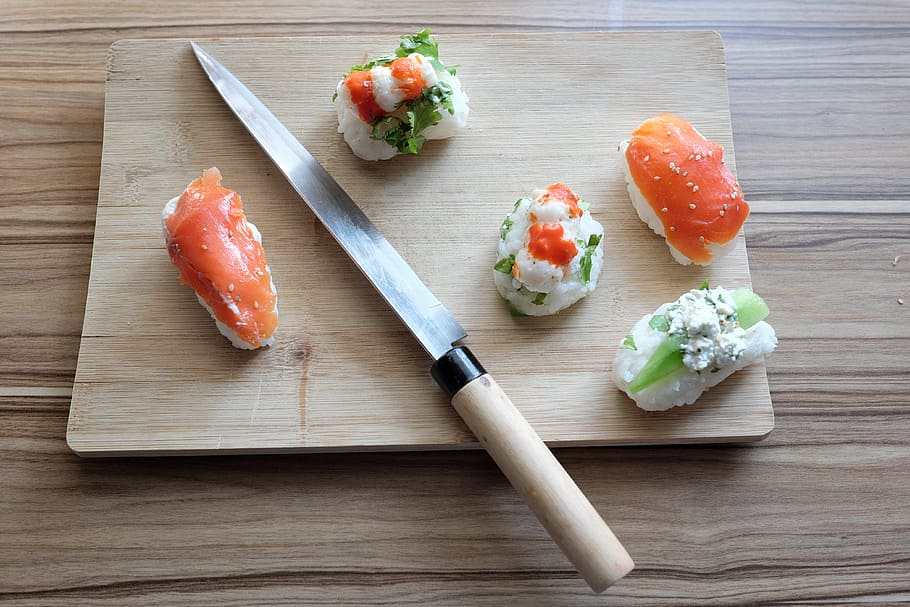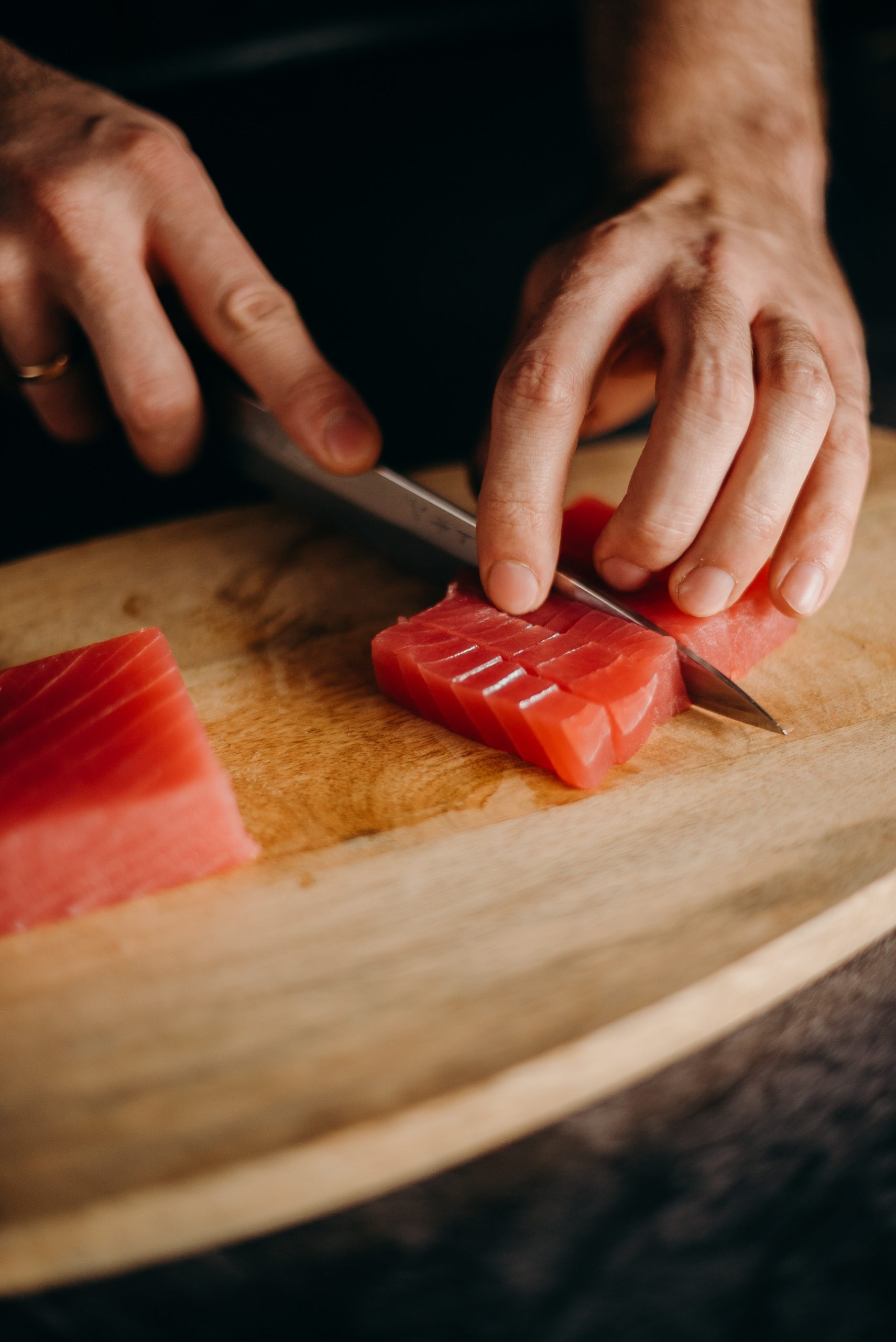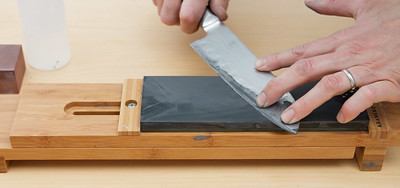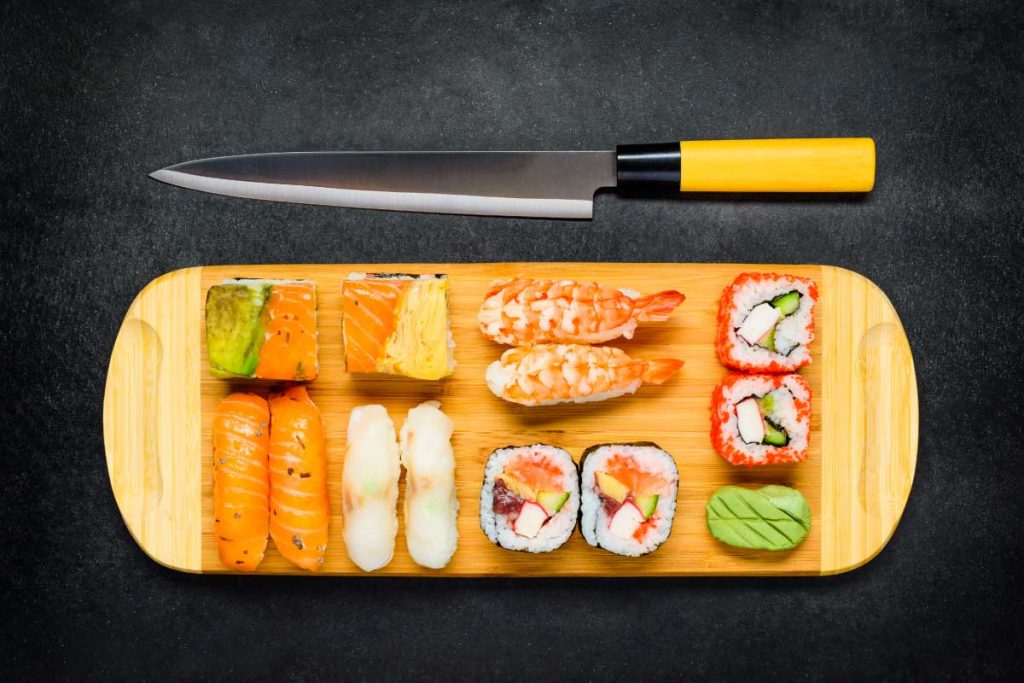You like sushi. Who doesn’t? But perhaps the sushi and sashimi spots in your area just aren’t cutting it. You’ve been thinking that it’s about time to take things into your own hands. Before you go ahead, you’re going to need some help; after all, what good is fresh fish without the right tools to help you prepare it?
While it's still possible to prepare sushi with your everyday santoku knife, you'll need a proper Japanese sushi knife if you want to get the full experience. We’ve gone out and tested a slew of different Japanese sushi knives so that you can spend more of your time perfecting your slicing technique. We’ve also included some tips on what you should be looking for when purchasing one for your kitchen, as well as how to care for the blade to keep your cuts nice and precise for years to come. There may be other sushi knife reviews out there, but we hope that you walk away from ours with a better understanding of this traditional Japanese knife.
Best Sushi Knife
For Beginners
Regular vs Sushi Knife
Although some types of sushi knives may seem like regular ones in appearance, the main difference between a sushi knife and a regular one is the sharpness. They're made to cut fine layers so they have a much lower degree of angle in order to be significantly sharper.
Single Bevel vs Double Bevel
Single bevel and double bevel refers to how many sides of the sushi knife are sharpened. A double bevel knife is sharpened on both sides while the single bevel is only sharpened on one side. By only sharpening one side, you can achieve a much smaller angle in order to make finer cuts.
The blade angle of a double bevel ranges from 20 to 30 degrees while a single bevel ranges around 15 to 17 degrees.
Sushi Knife Material
Most common kitchen knives are made out of stainless steel, due to its rust resistance and easy maintenance, but it limits the sharp edge of the blade. A proper Japanese sushi knife is used to make precise cuts, so they need to be made with a material that can handle being extremely thin without breaking apart.
High-carbon steel has a high Rockwell Hardness score, which allows the blade to be very thin while providing power. The downside of using high-carbon steel is that it’s very prone to rust, so a good level of care is required.
Different types of Sushi Knife
Most people think that a sushi knife is only one type, but it's actually a family of knives. In a sushi and sashimi restaurant, each tool has a specific purpose so that each cut can be complete in the best way possible.
Yanagiba
Yanagiba vs Sujihiki
The Sujihiki is similar to Yanagiba in terms of length and shape. However, the main difference is that Sujihiki is double beveled while the Yanagiba is single beveled. This small difference makes Sujihiki much easier to use and versatile, but less sharp. As a result, the use of Sujihiki is more common in Western sushi restaurants rather than the yanagiba. However, Japanese sushi chefs believe that having a sharp blade to make smooth, even cuts to the sushi and sashimi a significant difference, so the yanagiba is considered the best sushi knife in Japan.
Deba
The deba is the chef knife of a sushi restaurant. The blade is much shorter than the yanagiba and much thicker. Although the deba is used primarily for filleting a fish, it’s an all-around tool so it can perform other tasks such as cleaving vegetables and cutting poultry. However, since the deba is single beveled, it’s not meant for cutting through bone or other heavy duty tasks.
Usuba
The usuba is used for cutting vegetables. Unlike the Yanagiba, the usuba is flat at the end and takes on a rectangular shape. Unlike other knives with this shape, the usuba is thin and single beveled in order to make clean cuts into vegetables. The usuba has superb performance, able to make fine cuts and perform delicate actions such as rotary peeling.
Other Specialty Sushi Knives
Apart from the 3 sushi knives mentioned above, there are others that are used for very specific tasks.
- Takohiki: The Takohiki blade is slightly longer than the Yanagiba and curves up instead of a straight point at the end. The Takohiki was used for the same purpose of cutting sashimi in eastern Japan. Although the Yanagiba is more popular today, some people still prefer the use of Takohiki.
- Fukuhiki: The Fuguhiki has similar length as the Yanagiba but is much thinner and narrower. These features of the Fuguhiki are designed specifically for cutting fugu, which needs to be cut in extremely thin slices without touching the poisonous organs.
- Sushikiri: The sushikiri has a flat tip with a rounded blade. This unique shape is made specifically for making seamless sushi and sashimi roll cuts.
- Unagisaki: The unagisaki specializes in handling eels. This sushi knife has a sharp turn at the tip, inverse of the yanagiba and similar to that of a katana’s tip. This tip shape helps filleting eels a lot easier.
best Sushi Knife Buying Guide
Choosing Your Blade
The first step to buying the best sushi knife is to choose the type of blade you need. If you want a one that can also function as an overall tool, then the deba is your choice. The Usuba is great for cutting vegetables and the yanagiba is the choice for cutting raw fish.
Blade Material

The blade material is one of the biggest factors to consider for any sushi knife. Cheaper ones tend to use stainless steel, which is the go-to material for standard kitchen knives because of its easy maintenance. While this is convenient to have, there’s a limit to how sharp it can be. Therefore, higher quality blades are made with high-carbon steel but also require a greater level of care in exchange.
Price
Japanese Sushi knives can get very expensive and if you’re a beginner, we recommend investing into a lower cost, easily maintainable knife first. Higher grade ones are made with materials that can rust easily so once you've had some practice maintaining the material, it can time to invest into a professional grade.
Blade Length

When cutting sushi, you want to make each cut one stroke for seamless slices. This may take time and for beginners, we recommend starting with a longer blade of 10-12 inches. Once that becomes an easier task, you can go shorter or stay if you prefer the longer one.
Handle
The handle is equally as important as the the blade itself. You want to get a good balance of comfort and grip while being able to exert enough force. For those using sushi knives at restaurants, you’d want to prioritize comfort with the grip while those used at home may want a handle that can exert enough power to cut different kinds of food at ease.
Left handed sushi knife
Unlike choosing other western blades, these are single-beveled, so it matters which hand you use. Most are made for right-handed use, but whether you use your right or left, you should always check whether the sashimi knife in your cart is a left handed sushi knife or not.
How to Use a Sushi Knife?
How do you sharpen a sushi knife?
Sharpening a sashimi knife is slightly different from a regular knife. In order to maintain the razor sharp features of the knife, you'll need a whetstone and some water to get started.
Step 1: Submerge the Whetstone in Water
Submerge the entire whetstone in water for 10-15 minutes, until all the air bubbles come out. Sharpening should always be done with water or oil and the whetstone constantly provides fluid while its being sharpened. Once the air bubbles stop coming out, place your stone on a leveled surface, on a towel.
Step 2: Sharpening the Blade

Sharpen your blade at a 10-15 degree angle and keep constant pressure on the blade. Start with the tip and gradually make your way down to the base. While sharpening, constantly splash water onto the whetstone to keep it from drying out. You'll know that you're finished when you start to notice a burr on the side.
Step 3: Honing the Blade
In order to get rid of the burr, you'll hone your knife by sharpening your blade at a diagonal against the whetstone. This helps to grind out the burr on the side of your sashimi knife and make it smooth again.
Step 4: Test it Out
A good way to test whether your sushi knife has a sharp edge is to try cutting paper. If you're able to cut a normal piece of paper with ease, then your blade is ready to use.
Step 4: Apply Tsubaki Oil for Maintenance
If you're not planning on using it for a while, it's necessary to apply oil to avoid rust. Tsubaki oil performs the best and you put a couple drops onto a piece of cloth. Apply that piece of cloth onto the sashimi knife and make sure you cover the entire blade.
Best Yanagiba
product | blade material | handle material | length | price |
|---|---|---|---|---|
high-carbon steel | Polypropylene blend | 8.25" | ||
stainless steel | light brown wood | 10" | ||
VG-10 Stainless Steel | Rosewood | 9.5” | ||
VG-10 Stainless Steel | African Blackwood | 12” | ||
German Stainless Steel | Traditional wood | 12" | ||
High Carbon Stainless Steel | Magnolia/Rosewood | 9.5" | ||
AUS-8 Steel | laminated pakkawood | 9.5" | ||
VG-10 Stainless Steel | Rosewood | 10.5" | ||
Blue Steel #1 | Ebony | 10.5" |
If you’re looking for a beginner’s yanagiba that won’t break the bank, then the Kai Wasabi Black Yanagiba Knife is a great choice. The blade is a well-polished yanagiba made out of Daido 1K6 high-carbon steel, which gives it a Rockwell hardness between 57 and 59. It also has a limited lifetime warranty so you can be certain that the company believes in its product. This one is slightly on the shorter side for a yanagiba, which makes it harder to use for cutting raw fish, but can be more multi-purposed.
Pros:
- Limited lifetime warranty
- Multi-purposed
Cons
- Short for yanagiba
[Beginner’s Choice]
The Lucky Cook Sashimi Sushi Knife is also a great low budget starter choice for those that are getting into using sushi knives. The blade is at 20 degrees, which isn’t as sharp as normal yanagiba, but enough to get the job done. It’s made out of stainless steel which is more stain and corrosion resistant. Since a higher quality blade requires more maintenance, this is a great beginner’s choice for learning to maintain a yanagiba as well.
Pros:
- Affordable starter yanagiba
Stain & corrosion resistant
Cons
- No sheath
- Not sharp for yanagiba
The Yoshihiro Damascus Japanese Slicer Knife is a double beveled sujihiki that we need to recommend. Compared to other yanagiba in this price range, this blade is much easier to maintain while being able to retain a good level of sharpness. In addition, the double bevel allows this tool to be versatile, able to cut other meats and vegetables with ease and can be used both professionally and at home.
Pros:
- Easy to maintain
- Material prevents food from sticking to blade
- multi-purposed
Cons
- Not as sharp for yanagiba
The Cangshan J Series Sashimi Knife is a great item under $200 that’s a great choice for intermediate and beginner chefs. It’s available in 8, 10, and 12 inches and each blade goes through a 6-stage heat treatment process that involves 67 thin layers of VG-10 stainless steel to create a unique pattern. The length versatility allows making raw fish cuts easier than other yanagiba and the 67 layers make this one easy to sharpen. The handle is carved in an oval shape and made out of African Blackwood which is ultra dense and secures a nice grip.
Pros:
- Easy to cut with
- Easy to sharpen
- Dishwasher safe
- Lifetime warranty
Cons
- Brittle
For beginners that are left handed, the Mercer Culinary Asian Collection Yanagi Sashimi Knife is a great choice. It’s hard to find yanagiba that left handed people can use. It’s made out of German Stainless Steel which is greatly resistant to corrosion and rust. For both the left and right handed version, it has a non-slip handle that gives you full control when in use. The blade is available up to 12 inches, which can help assist cutting sashimi in one slice. With the blade’s length, it’s also easy to cleave vegetables.
Pros:
- Left hand version available
- NSF-certified, non-slip
Cons
- Prone to breaking
The Yoshihiro Shiroko Kasumi Yanagiba is a high quality yanagiba with a traditional look. It’s offered in 3 perfect lengths and feels like a high quality tool. The blade is made with high carbon stainless steel, which gives it increased sharpness. However, compared to other items in this range, this one is more prone to oxidation and requires maintenance with a tsubaki oil in order to keep its integrity. Therefore, this blade is not meant for beginners and we recommend it to advanced/intermediate users.
Pros:
- sharp edge
- left hand available
Cons
- Requires care
- Costly for beginners
The Dalstrong Phantom Series Yanagiba is a great quality sushi knife at an affordable price. The blade is forged with one whole piece of material and nitrogen cooled to increase its strength and durability while being lightweight. The single side bevel is sharpened at 13-15 degrees to make precise cuts and comes with a locking sheath for safety. The product also has an ergonomic handle shape for a natural grip. The blade can get brittle if you make the wrong cut, but there’s no worries since this product comes with a lifetime warranty backed up by high quality customer service.
Pros:
- Lifetime warranty
- Full tang
- Locking sheath included
Cons
- Brittle at times
[ Best Overall ]
The Yoshihiro Hongasumi Yanagi Japanese Sushi Knife is a top tier Amazon’s Choice Item. What makes this blade special is that each is hand crafted with special care in Japan and imported.
It has a Rockwell Hardness of 62-63, allowing the blade itself to be thinner for enhanced precision. The shape of the Rosewood handle on this product is also very comfortable, making it easy to use for long hours. This is important since many professional sushi chefs often have to handle a sashimi knife for a long time.
Pros:
- Hand crafted
- Comfortable handle
- Left hand available
Cons
- Hard to maintain for beginners
The Yoshihiro Aonamiuchi Yanagi Kiritsuke Knife is a top tier yanagiba. It’s made of blue steel #1 which allows the blade to have a HRC score of 64, the strongest of all yanagiba material. The blade has an extremely high edge retention, allowing it to stay sharp for a long time.
It has extremely great balance of weight and you can tell that there was a long, careful thought put into the blade design. However, due to the material of this blade, it requires extreme care and is only recommended for professionals.
Pros:
- Top tier quality
- High edge retention
- Excellent balance of weight
Cons
- Requires extreme attention and care
- Recommended only for true professionals
Best Deba Knives
product | blade material | handle material | length | price |
|---|---|---|---|---|
high-carbon stainless steel | Pakkawood | 6" | ||
White Steel #2 | Shitan Rosewood | 7.5" | ||
High Carbon German Steel | high density G10 material | 8.25" | ||
AUS-10V Super Steel | Red Rosewood | 6" | ||
German Stainless Steel | Slip-resistant Santoprene | 6" | ||
Blue Steel #2 | Rosewood | 7" |
Kai 6715D Wasabi Black Deba
[ Beginner's Choice ]
The Kai 6715D Wasabi Black Deba is a great introductory sushi knife for beginners. It’s low cost while also having the deba quality.
The blade comes at a 16 degree sharpness with amazing edge retention. However, once you start to sharpen the knife, food may start to stick to it. It does have a nice lightweight grip, which makes it easy to use for long periods of time
Pros:
- Good for beginners
- Good edge retention
Cons:
- Rust if not maintained properly
- Sharpening makes food stick to blade
[ Best Overall ]
The Yoshihiro Shiroko Kasumi Deba is a relatively affordable product that has comparable quality with high end deba knives.
The blade is made with White Steel #2 which gives it a HRC score of 62-63. This deba is made specifically to filet fish and makes it really easy to do with its incredible sharpness.
It can also be used for cutting vegetables as well, but it’s not recommended to use for cutting through thicker bones.
You don’t need to be a professional chef to add this deba to your sushi knife collection, but you do need to maintain it well since White Steel #2 can easily rust.
Pros:
- Cuts easily
- Durable material
Cons:
- Requires heavy maintenance
- not multi-purpose
If you want a high quality beginner’s deba, then the KEEMAKE Deba may be your choice.
Compared to other low priced deba, this blade has a bit more weight, allowing it to make thin cuts while also being able to chop through ribs. This product has a price that competes with a beginner's knife, but the quality of a professional grade one. However, the downside is that unlike other stainless steel knives, this one is made out of High Carbon German Steel, so it’s more susceptible to rusting if not properly maintained.
Pros:
- Easily make thin cuts
- Able to make heavy duty chops
Cons:
- Rusts if not maintained well
The DALSTRONG Deba of the Shogun Series is a great addition to your growing knife set. The material has a HRC hardness of 62, which is one of the highest in this price range. It’s incredibly easy to make thin slices as the knife is only 3.5mm thick and has sufficient weight to add pressure to each cut. The sharpness is also amazing, allowing it to even cut through bones. However, one does need to be careful since the blade material is thin and can be quite delicate at times. Dalstrong has excellent lifetime warranty service, so if something does happen to get chipped, give them a call and they will quickly replace it with a brand new one.
Pros:
- Versatile
- Incredibly sharp
- Lifetime warranty
Cons:
- Delicate
For those that are looking for a beginner’s sashimi knife that’s easy to use, we recommend the Mercer Culinary Asian Collection Deba. With 6 degrees on one side and 15 on the other, this double beveled blade is much easier to use than single bevel deba. The blade is very versatile, able to cut fish, vegetables, and can fulfill standard tasks. A note of caution, this blade can only be hand washed, and the handle may loosen if used in the dishwasher.
Pros:
- Great edge retention
- Easy to use
Cons:
- Flimsy
The Yoshihiro Hongasumi Deba is one of the most high quality blades out in the market and is the perfect tool for making various fish recipes. To start, this blade is made with Blue Steel #2 which is one of the hardest materials used for knives. It has a nice and heavy weight for cutting through hard parts of the fish easily.
This product is not mass produced and each sushi knife is handmade in Japan, so you know that the artisan puts quality into each and every tool.
Since this high quality item does not come cheap, we recommend purchasing tsubaki oil and rust eraser with it for proper maintenance.
Pros:
- Incredibly hard material
- Hand crafted
Cons:
- Requires heavy maintenance
FREQUENTLY ASKED QUESTIONS
What kind of knife is best for cutting sushi?
Any knife can cut fish but a proper Japanese sushi knife, like the Deba or Yanagiba, is single beveled, which is necessary for making fine cuts to raw sushi.
What knife do sushi chefs use?
In order to prepare the best sushi rolls, professional sushi chefs use a variety of knives for their daily work. However, when it comes to the main sushi knives of their toolkit, most sushi chefs use either the Deba, Yanagiba, or Nakiri knife. These 3 traditional Japanese knives are a must have for preparing Japanese food and they are the chef's knife of the far east.
How much is a good sushi knife?
A good sushi knife will be priced around $100-$200, but if you want the best sushi knife, be prepared to spend more than $200. These Japanese knives don't come cheap since they're known for their ultra sharp and thin blade. On the contrary, because these knives are extremely sharp, you can use these knives to cut almost anything, and they're not limited to use on just slicing fish and sashimi slicing.
What is a sushi knife called?
Sushi knives in Japanese is called "Sashimi Bocho", which literally means sashimi knife. This is the umbrella term and there are many different categories of sushi knife, such as the yanagiba knife, deba knife, nakiri knife, takohiki, etc.
Do I need a special knife for sushi?
You don't need a special knife to cut sushi or sashimi, but at the same time, using just any knife without a sharp edge will make dull cuts, thus affecting the taste of the sashimi. To get razor sharp cuts into your sushi, you'll definitely need a good sashimi knife.
What is a Yanagiba knife used for?
Yanagiba knives are a special Japanese knife used to cut sushi and sashimi. The knife features a long, sharp blade and a wooden handle that allows you to make precise cuts to the fish in one slice, keeping the sashimi texture.
What is Uraoshi?
Uraoshi is the term for the flat, level side of Japanese knives. The purpose of the uraoshi is to reduce the drag force when slicing fish, to avoid food from sticking to the knife blade.
What is a usuba knife?
A usuba knife is a special Japanese knife used for slicing vegetables. The Usuba knife is another quality knife that has a single bevel edge and is known for its incredibly sharp edge.























